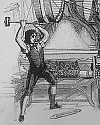
On 2 Jan 1813, dozens of Luddites were put on trial. You may have heard of the word “Luddite” as now used to mean someone resisting the advance of technological progress. If you don't know where the term came from, or know only vaguely, you are missing an interesting and important part of technological and social history. You can catch up with some of that history in a chapter on the Machinery Riots from James Burnley's The Romance of Invention: Vignettes From The Annals of Industry and Science (1886).
A special Commission opened at York, England on 2 Jan 1813, to put on trial 66 persons for offenses connected with Luddism. Within days, seventeen of them had been executed on the scaffold. Taking their name from (perhaps mythical) Ned Ludd, Luddites vowed to destroy the factory mechanization they blamed for their unemployment. Riots began in 1812, and spread north from Nottingham where half of the population were receiving parish relief. Falling prices for goods, bad harvest increasing prices for food, wages at starvation level, costs of war and lost foreign markets contributed to the economic distress of the working class. One thousand looms were broken up in Nottingham, and a law was passed making destruction of machinery a capital offence. Did you know that participation in machinery riots brought a death sentence?

On 2 Jan 1920, Isaac Asimov was born, a prolific author of science books in which he popularized science (not to mention his widely-read science fiction). Today's book pick is: Asimov's Chronology of Science & Discovery: Updated and Illustrated, by Isaac Asimov. It is written as a chronological encyclopedia with many easy to digest entries. Asimov's accessible writing style conveys complex ideas while staying entertaining. As with any of Asimov's books, it is delightful to read. Your Webmaster has it on his bookshelf. But if your interest runs to something different, you will likely find Asimov wrote about it. Just follow the link, and browse on the author's name.
It is available from Amazon, typically about New from $79.99. Used from $3.10. (As of earlier time of writing - subject to change.)
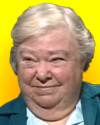 | If our tongues were as sensitive as these radiation detectors, we could easily taste one drop of vermouth in five carloads of gin. |
| no image | What are they doing, examining last month's costs with a microscope when they should be surveying the horizon with a telescope? [Acerbic comment about directors of Brunner Mond, where he worked.] |
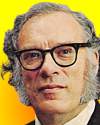 | A neat and orderly laboratory is unlikely. It is, after all, so much a place of false starts and multiple attempts. |
| Before you look at today's web page, see if you can answer some of these questions about the events that happened on this day. Some of the names are very familiar. Others will likely stump you. Tickle your curiosity with these questions, then check your answers on today's web page. | |
| Births | |
 | On 2 Jan 1920, Isaac Asimov was born. As a writer of science fiction, he coined the term “robotics,” and was also a prolific author of science non-fiction books for the layperson. Born in Petrovichi, Russia, he emigrated with his family to New York City at age three. As a trained scientist, he taught at Boston University. In which field did Isaac Asimov teach? |
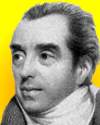 | Charles Hatchett, born 2 Jan 1765, was an English manufacturer, chemist, and discoverer in 1801 of a new element, which he called columbium. Forty years later another chemist, Heinrich Rose of Germany, rediscovered the metal and gave it the name by which it is now known. It is used in arc-welding rods for stabilized grades of stainless steel. What is this element? |
| Deaths | |
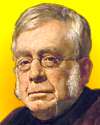 | Sir George Biddell Airy (1801-1892) was the seventh British Astronomer Royal. In his life he studied interference fringes in optics, made a mathematical study of the rainbow, and computed the density of the Earth (with experimental measurements made at the top and bottom of a deep mine.) What simple device did Airy use to make the measurements to compute the density of the earth? |
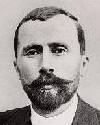 | Léon-Philippe Teisserenc de Bort (1855-1913) was the French meteorologist who discovered one of the layers of the atmosphere. Using unmanned, instrumented balloons, He found that above an altitude of 7 miles (11 km) temperature ceased to fall and sometimes increased slightly. What name did Teisserenc de Bort give to this layer of the atmosphere? |
| Events | |
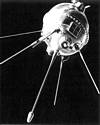 | On 2 Jan of a certain year, the first lunar space shot to escape the Earth's gravitational pull, the unmanned Luna I, was launched by the Soviet Union. It passed to within 4,600 miles of the moon before moving on to a solar orbit. In what decade did this space shot take place? |
 | On 2 Jan 1870, construction began on the Brooklyn Bridge to cross the East River, New York City, USA, with a single span, a breadth of 1,600 feet navigable water. The 13 year project was designed by the father of the engineer who finished the project. The father, a German-American, is known for establishing the first U.S. steel-wire cable factory. (He died from injuries while supervising preliminary construction operations for the Brooklyn Bridge.) Who was the designer of the Brooklyn Bridge? |
Fast answers for the previous newsletter for January 1: bosons • the patient is injected with slightly radioactive material containing tagged molecules that behave like glucose and are consumed within cancerous tissue which the PET scanner can then detect • rear admiral • Heinrich Hertz • decade including the year 1966 • ENIAC.
 If you enjoy this newsletter, the website, or wish to offer encouragement or ideas, please send feedback by using your mail reader Reply button.
If you enjoy this newsletter, the website, or wish to offer encouragement or ideas, please send feedback by using your mail reader Reply button. Your click on a Facebook, StumbleUpon, or other social button on the site webpages is also a welcome sign of appreciation. Thank you for using them.
© This newsletter is copyright 2020 by todayinsci.com. Please respect the Webmaster's wishes and do not put copies online of the Newsletter — or any Today in Science History webpage. (If you already have done so, please remove them. Thank you.) Offline use in education is encouraged such as a printout on a bulletin board, or projected for classroom viewing. Online, descriptive links to our pages are welcomed, as these will provide a reader with the most recent revisions, additions and/or corrections of a webpage. For any other copyright questions, please contact the Webmaster by using your mail reader Reply button.
--
If you do not want to receive any more newsletters, Unsubscribe
To update your preferences and to unsubscribe visit this link
Executive Real Estate Business Class
-
"It was like a man with wings. It wasn't like anything you'd see on TV or in a monster movie." ...
About the publisher
Search This Blog
Blog Archive
-
▼
2021
(585)
-
▼
January
(109)
- Ian Kershaw on why Hitler declared war on America
- On This Day for January 31 - Guy Fawkes executed i...
- Newsletter for Sunday 31 January.
- January 31: Slavery Abolished in the USA, Guy Fawk...
- On This Day for January 30 - “Great Soul” assassin...
- Newsletter for Saturday 30 January.
- January 30: Oliver Cromwell Ritually Executed, Mah...
- On This Day for January 29 - Iraq, Iran, and North...
- Newsletter for Friday 29 January.
- January 29: Romeo and Juliet, Coca-Cola and the Se...
- 'The Food That Built America' Is Back!
- On This Day for January 28 - Explosion of the spac...
- Newsletter for Thursday 28 January.
- Inside The Still-Mysterious Circumstances Of Heath...
- Demystified: What’s the Difference Between a Presi...
- On This Day for January 27 - Vietnam War ended, Wo...
- Newsletter for Wednesday 27 January.
- January 27: Kaiser Bill is Born, the Siege of Leni...
- You are now unsubscribed
- What The Wild West Actually Looked Like in 48 Reve...
- New Savings! $50 off Family Memberships
- On This Day for January 26 - First European settle...
- Newsletter for Tuesday 26 January.
- January 26: Catholic Counter-Reformation, British ...
- On This Day for January 25 - Claudius affirmed as ...
- Newsletter for Monday 25 January.
- January 25: São Paulo Founded, Charles Wilkes Disc...
- Queen Victoria and Prince Albert's marriage | Wors...
- On This Day for January 24 - Opportunity's Mars la...
- Newsletter for Sunday 24 January.
- January 24: Scouting for Boys, Apple's Macintosh a...
- On This Day for January 23 - Madeleine Albright sw...
- See All That's Interesting Most Popular Articles
- Please Confirm Subscription To Our Newsletter
- The "Alaskan Avenger" Who Attacked Sex Offenders W...
- On This Day for January 22 - Roe v. Wade ruling, L...
- Newsletter for Friday 22 January.
- On This Day for January 21 - First commercial Conc...
- Newsletter for Thursday 21 January.
- Need Context with Your News?
- Demystified: Where Do Honeybees Go in the Winter?
- On This Day for January 20 - Barack Obama sworn in...
- Newsletter for Wednesday 20 January.
- On This Day for January 19 - Rule in India transfe...
- Newsletter for Tuesday 19 January.
- On This Day for January 18 - German Empire establi...
- Newsletter for Monday 18 January.
- January 18: King of Siam Kills the Crown Prince of...
- Queen Victoria and Prince Albert: was their union ...
- On This Day for January 17 - Hawaiian monarchy ove...
- Newsletter for Sunday 17 January.
- January 17: US-Modoc War, the UN Security Council ...
- On This Day for January 16 - Beginning of Persian ...
- Newsletter for Saturday 16 January.
- January 16: Ivan the Terrible, Louis XVI's Death S...
- The Tragedy Of David Reimer, The Boy Forced To Liv...
- On This Day for January 15 - British Museum opened...
- Newsletter for Friday 15 January.
- January 15: Henry VIII and the Church of England, ...
- On This Day for January 14 - Premiere of Giacomo P...
- Newsletter for Thursday 14 January.
- January 14: The Dutch Conquer Malacca, the US Revo...
- Demystified: Why Does Water Freeze from the Top Down?
- On This Day for January 13 - Émile Zola's “J'accus...
- Newsletter for Wednesday 13 January.
- January 13: 1st Issue of "The Times" of London, Ch...
- On This Day for January 12 - Haiti severely damage...
- Newsletter for Tuesday 12 January.
- January 12: A Day of Coronation, Gandhi's Last Fas...
- On This Day for January 11 - Amelia Earhart's Hawa...
- Newsletter for Monday 11 January.
- January 11: Spices, Morse Code, Insulin and 55 Yea...
- The real history behind Bridgerton
- On This Day for January 10 - Common Sense publishe...
- Newsletter for Sunday 10 January.
- January 10: Thomas Paine Publishes Common Sense, T...
- On This Day for January 9 - Election of Mahmoud Ab...
- THE IGBO LANDING - HOW THEY COMMITTED SUICIDE
- Newsletter for Saturday 9 January.
- January 9: Joan of Arc's Trial, the Daguerreotype ...
- The Biggest Historical Discoveries From 2020 And M...
- On This Day for January 8 - Anniversary of Grimald...
- Newsletter for Friday 8 January.
- January 8: US National Debt Briefly Hits $0, Forma...
- On This Day for January 7 - Galileo's discovery of...
- Newsletter for Thursday 7 January.
- January 7: A Day of Invention - The Typewriter, Hy...
- On This Day for January 6 - Epiphany, Richard II i...
- Newsletter for Wednesday 6 January.
- January 6: Charles I put on Trial for Treason, FDR...
- Meet The Real-Life Goodfellas Whose True Stories W...
- On This Day for January 5 - Golden Gate Bridge con...
- Newsletter for Tuesday 5 January.
- January 5: Richmond Burns, The Nazi Party Forms, A...
- Last Call for 30% off Memberships
- On This Day for January 4 - Burma granted independ...
- Newsletter for Monday 4 January.
- January 4: The Colt Revolver, a 33 Year Strike and...
- Dangers of Victorian London| Roman history quiz | ...
- On This Day for January 3 - Martin Luther excommun...
-
▼
January
(109)
-
Blogroll
-
About
HistoryFact










0 comments:
Post a Comment